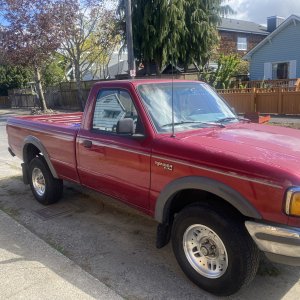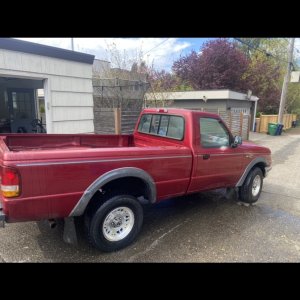Here’s the most recent concept;
& a few thoughts:
Remember, this is all for playing around and show candy. Never going to do any serious work with it.
The winch would be installed at the front most part of the trailer. Its sole purpose would be to pull something up ramps onto the trailer in a straight line. I can’t imagine where it would ever pull on an angle that would be more than 2 or 3° off center. It’s basically to pull another trailer on top of this trailer.
I have two winches in the shed of miracles, but I am only going to use the 2500 pound badlands winch on this trailer.
Note the dimensions: lower deck is 30 inches off the ground, there is a 15 inch rise to the upper deck.
Lower deck has 10 feet of free deck to the ankle braces, 11 feet from the tail to the teo 4 inch deep uprights, with another 4 inches of length between those uprights.
Upper deck is 65 inches long
The ramps I have are 72 inches long, but about 65 inches long on the slope.
The upper deck pivots up at the rear. It sits on the tongue part of the frame in 3 places by gravity: the two pivot points, and where the frame comes to an arrow head point. The upper deck extends about 2 feet past that arrow head point.
Since the very front of the upper deck is not supported directly by the frame, I welded a balance bar across the nose of the frame at the arrow point, that extends out about 10 inches on either side of that arrow point. There is a bar that goes from side to side on the upper deck that rests in that piece of angle balance bar. Both are drilled at the end of the welded angle, so I can put pins through there to hold the two pieces together. It is not a matter of holding the upper deck down, it’s a matter of holding one side down while you stand on the other side.
Now, if you think of a cable going from the winch, a few inches above the very front of the upper deck, straight down the length of the trailer to grab another trailer behind it about 20 inches off the ground (Hitch height), and pull it in a straight line on top of the lower deck.
Yesterday, and today, I disassembled the upper deck above the solid frame, and then rebuilt it with a piece of aluminum channel down the centerline to hold the winch, plus a couple pieces of other 1 1/2 inch aluminum stock I had, and I maintained the outer perimeter from before. I had to modify one pivot point, and I had to remove and reinstall the balance bar that holds the two pins, but now it is square and level.
My concern from before, is wondering if the upper deck assembly will be strong enough to withstand the length-wise pull of the winch: will it crunch length wise? Will it flip up?
The lateral steel piece that sits in the pin bar, actually sits in front of the arrow point, not on top of the trailer frame. Hence, if I make the length wise channel solid to that point, when you pull on the winch, it will only be pulling about 12 or 20 inches on that aluminum frame before it is literally blocked from movement by the balance bar assembly. I’m sure I can make that 12 to 20 inches strong enough that it won’t crush. Depends in the balance bar should be enough to keep the upper deck from flipping up.
As regards cable scuffing, I actually like your idea of a roller, and I will explore that. It will be functional, and it fits right into the whole cool factor of this whole contraption.
On the other hand, there’s nothing about this that is practical and functional for every day use. If a roller won’t work out, I will probably cut a three or 4 inch wide block of that aluminum, with a dip in the middle, that the cable can ride in. The steel cable will wear out the aluminum, but it should not damage the steel cable. I would repeat that at the tail end of the trailer if the cable rides low enough to touch the tail of the trailer. Even if I had to change those blocks after a half dozen uses, that fits into my use of the whole thing.
The last thought I had, late this afternoon, considering that the truck, trailer and trailer to be loaded will always be in a straight line, I had the thought of actually mounting the winch behind the toolbox on the bed area of the truck, with the cable going up over a roller or pulley on the front most part of the trailer. It would provide the identical, pulling power, but by the configurations, it would also be pulling the pivoting upper deck down constantly, eliminating the worry of it flying up.
I am still thinking it all out, but I’m still wide open to suggestions. Today I got the upper deck square and straight. I think when I tackle it again with a fresh mind, it will make sense what to do.
EDIT afterthought: I always knew the pressure treated was just temporary. The new aluminum structure probably weighs 1/3 or 25% of what the pressure treated temp structure weighed. That should compensate for the weight of the winch.
And as I write all this, I had the thought that I could mount the winch to the steel frame underneath the arrow point, and run the cable through a hole in the upper deck over a pulley, so the winch doesn’t need to move at all, all the pulling power is on the steel frame, and it also makes the winch less noticeable and harder to get at from a theft security standpoint.














